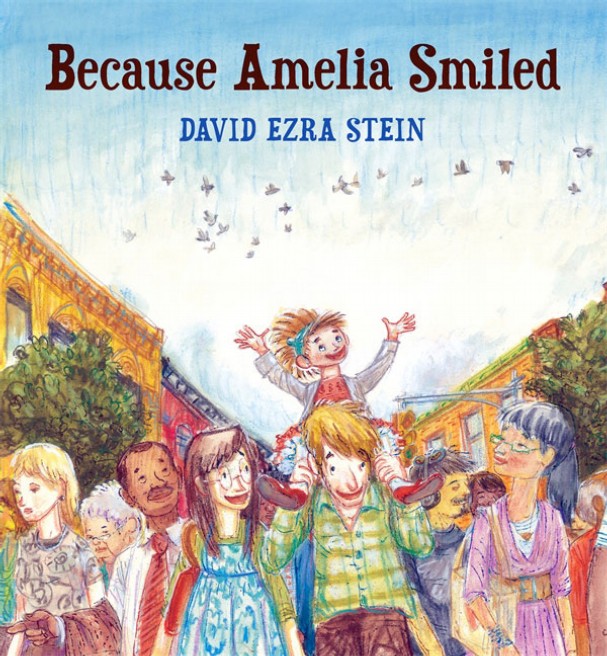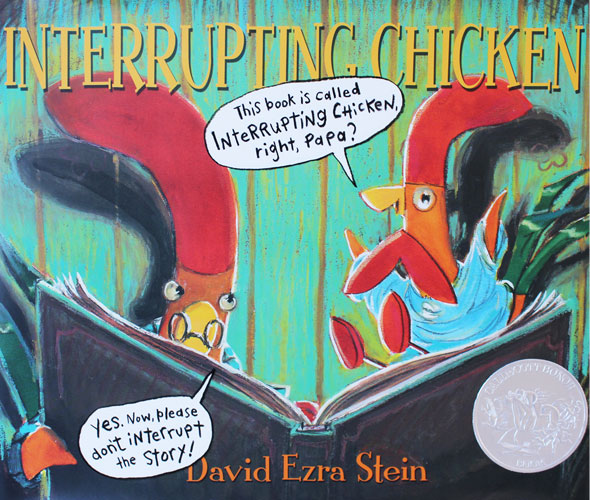 David Ezra Stein is the author/illustrator of nine picture books, including “Interrupting Chicken,” which won a Caldecott honor, and “Leaves,” which won the Ezra Jack Keats award and was a Publishers Weekly Best Book of the Year. His latest book, “Because Amelia Smiled,” shows the far-reaching effect one small action can have. The following is a complete transcript of his interview with Cracking the Cover.
David Ezra Stein is the author/illustrator of nine picture books, including “Interrupting Chicken,” which won a Caldecott honor, and “Leaves,” which won the Ezra Jack Keats award and was a Publishers Weekly Best Book of the Year. His latest book, “Because Amelia Smiled,” shows the far-reaching effect one small action can have. The following is a complete transcript of his interview with Cracking the Cover.
Have you always wanted to be a writer/artist?
Always have been. I didn’t know this would be my career until I was about to finish college. But I’ve always written and drawn for myself. It’s a personal thing that I would do whether I got paid or not. (. . . I hope my publisher doesn’t read that.)
What came first, writing or art?
Art. I didn’t know how to write till I was 5 or 6. But I used to draw and tell stories into a tape recorder before that. I remember one time my mom typed up a joke book that my sister and I wrote with her. It was called, Look Both Ways Before Crossing the Bathtub.
Why do you create for young people?
I have a strong inner child. Even though I’m big, I remember what it’s like to be small and to look up at the world from low down. I remember what it’s like to have other make choices for me and to long for the power to choose for myself.
Where do your ideas come from?
Everyday life. Feelings or situations I can’t readily explain, that I’m trying to figure out. Funny ideas I have while I’m watching the world and wading in the world. My eyes, ears, and heart are usually open looking for stories. Writing can be a way of taking even the worst situation and making something beautiful out of it. It’s like playing the blues, for me.
How did “Because Amelia Smiled” come about?
I wrote the original version of the story almost 14 years ago while walking home from the subway. I had a lot on my mind, namely how people are all connected to each other. The story just started coming as I was walking along. I ended up showing it to my children’s book illustration teacher at art school, and she loved it. She got me in touch with a publisher, and I went to meet the editor.
The editor wanted to publish my story. At some point she even quoted me a price. But it wasn’t so easy. While she loved the story, she wasn’t sold on the art. I was still in school and couldn’t really decide on a style for the book. And the publisher wasn’t able to guide me. I felt lost at sea. After about six months of trying, the deal fell through.
I put Amelia aside for years, as I broke in to the business with other stories, and created eight other books. I won the Caldecott Honor for Interrupting Chicken. My editor at Candlewick Press asked me for ideas for my next book. I submitted about ten. From among those, she chose Because Amelia Smiled. I knew it was time to make the story into a book. And I did it!
 Have you been to all the places shown in your book?
Have you been to all the places shown in your book?
No. But I tried to use places I have been, or places that people I know have been—places I have a connection to. And some places are places I’d like to visit. They’re all beautiful locations. The book is like a vicarious world tour you can take on your couch.
Why is Amelia’s smile so important?
Even though she doesn’t know it, Amelia’s smile brings joy to so many people around the world. It’s an injection of positive energy that inspires everyone who notices it. This is important for kids and grownups to realize: They matter. What they do, matters.
What makes you smile?
My son always makes me smile, even when he’s being annoying. Kids, in general, make me smile. They are so generous with their attention and imaginations. They don’t really know how not to be. They’re alive.
How long does a project like “Because Amelia Smiled” take you from start to finish?
Amelia was probably the most ambitious book I’ve ever made. Not counting the fourteen years of life experience I gathered before making the art, it took roughly two years to make. The finished art alone took about seven months.
What is it about your work that appeals to young people?
It’s funny and it has love in it.
Looking back, how has your work evolved?
I am now probably more conscious of how a book reads aloud. This comes from reading my books over and over to all kinds of audiences. I can see an artistic evolution form one book to the next as well. I’ve tried all sorts of art techniques in my books, and I love combining and recombining them for new projects.
What are you working on now?
I’ve got a funny squirrel book called Ol’ Mama Squirrel coming out in the spring of ‘13 and I’m working on a funny dinosaur book now.
Is there a particular book from your childhood that still resonates with you?
I still love Calvin & Hobbes by Bill Watterson. All those collections of his comics. James Marshall’s work is gold to me. I love Sylvester and the Magic Pebble by William Steig, and Frederick by Leo Lionni. That book is a love letter to artists and poets. It’s a gift that keeps on giving!
